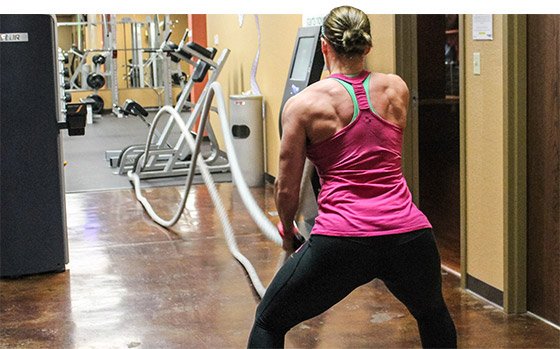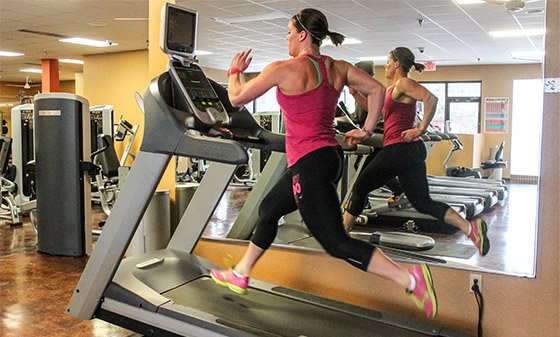For many of us, cardio is an integral part of our training regimen. We pound away on the treadmill or stairmill for hours because we think it's the only way to get lean. During my contest prep last year, I was the epitome of a treadmill slave. I thought all the work would be worth it; I was sure it was helping prepare my best physique for the stage.
Instead of my best-ever presentation, the only thing I earned from all that cardio was metabolic damage. I want to share my story so you don't make the same mistakes.
Here's what I learned about breaking the chains of cardio, and how I found a better way to get ready for the stage.
THE STEADY BURDEN
In October 2012, I began my preparation for a show the following spring. Before I began preparing, I practiced one hour of steady-state cardio six days each week.
Although that schedule was keeping me fairly lean, I knew I had to step up my game for the upcoming show. So I doubled my cardio workload to two hours, seven days per week. I thought I was doing myself a favor.
On top of the increased workload, I restricted my diet more than ever, putting greater strain on my body. In previous preps, I allowed one or two slip-ups where I consumed too much peanut butter, rice cakes, or sweet potatoes, or my "cheat meal" was a free-for-all binge. This time I did not even have an extra almond.

My only cheat meal from October to March came once on Thanksgiving—I allowed a small dessert. Other than that, I ate my bland chicken and broccoli while watching my family enjoy all my favorite foods.
The combination of excessive cardio and a low-calorie diet made me experience several medical issues. I was always sore. My knee, hip, or lower back irritated me. My hair was dry, brittle, damaged, and fell out. My skin was dry and broken. My hands and feet turned a yellowish orange and my eye twitched uncontrollably. I quit having a menstrual cycle for around a year and was constipated for several months.
My stomach growled 24/7. I had a hard time sleeping and woke several times throughout the night. I usually resorted to taking Advil PM to fall asleep. I had severe mood swings, was depressed, and had no energy. I felt like walking death. The smallest things brought me to tears or anger.
To make matters worse, I could not drop weight. I didn't know what was wrong with me! My problem areas were bigger and I had lost a lot of muscle. I was so confused. How could I look worse? Why was I having a harder time getting show ready when I'd stepped up my game, done more cardio, made more sacrifices, and given it my all?
When the show finally came around, I didn't look awesome like I thought I would. I looked far worse on stage than I did during my first competition. I was a wreck.
THE NORTON EFFECT
I was mentally, physically, and emotionally exhausted. I poured everything into that prep and I looked worse. I knew something was wrong with my plan, or me, but I wasn't sure what it was.
I started to search around online to find a solution. I found Dr. Layne Norton's vlog on Metabolic Damage and burst into tears after watching it. I realized that excessive cardio and a caloric deficit—my whole plan—was hurting me at a metabolic level. I decided to get help.
Layne saved me from myself. I lived the extreme life because I believed it was the only way. I bought into the whole "eat clean" every 2-3 hours to keep your metabolism on fire and do multiple cardio sessions (fasted when possible) per day because that is what dedicated and serious competitors do.
I once feared that I'd spend the rest of my life doing 1-2 hours of daily cardio to keep off excess weight. I had already missed so many important events with my loved ones because of my 2-3 hour gym sessions and strict dieting. I was sick at the thought of being forever chained to this regimen.
Norton taught me that it was all complete hogwash. You do not have to live that way to get stage lean! Now, I follow flexible dieting, commonly referred to as "If It Fits Your Macros," or IIFYM. I've increased my food intake by more than 1,000 calories per day. I don't restrict food groups or eat out of Tupperware every 2-3 hours.
I perform absolutely zero steady-state cardio. On this program, I feel 100 percent better and can still maintain the look I need to be a competitive figure athlete.

Ashley's New HIIT Cardio Protocol
With Norton's help, I traded in hours of steady state cardio for 20-minute, high-intensity interval training (HIIT) sessions three times per week.
Here's what one of my new typical cardio workout looks like:
- Warm-up, 5 minutes at an easy pace
- Complete 20-second intervals at max effort
- Recover 1-2 minutes at an easy pace
- Repeat 8 times
- Cool-down, 5 minutes at an easy pace
Since making the switch, all of my before-mentioned medical and metabolic issues have disappeared. I have added an insane amount of strength and muscle. I am leaner than I have ever been in an offseason.
HIIT training is proven to allow strength gains while shedding body fat.1 It's also been proven to increase hypertrophy, overall strength, and power.4 Unless you love being a hamster in a wheel, give it a go!
My 5 New Cardio Rules
I enjoy my life again and am no longer a social hermit. I have the freedom to go out, eat, and order from a regular menu. I attend social events without feeling anxious about which foods will be there and I no longer have severe mood swings or depression. I've improved my entire life by making simple changes to my fitness lifestyle.
These are the 5 rules I used to break free of my cardio chains:
Give it your all
Your high-intensity activity should range between 15-30 seconds. During those 15-30 seconds, you should go 100 percent all out. During the last few seconds of a 30-second work interval, you might feel like you're about to die—force yourself to keep going!

Mimic lifts
You don't have to stay chained to a treadmill for your HIIT cardio. To help maximize muscle hypertrophy, strength, and endurance, do cardio exercises that are similar to lifts you would perform in the weight room. A few of my favorites are car pushes, tire flips, incline sprints, the rowing machine, battling ropes, stair mill sprints, and beating the crap out of a heavy bag!
These exercises can increase performance while avoiding competing adaptations.4 Concurrent training—combining resistance training and cardio—can help you optimize your strength and gains.2
Dial in your work/rest ratio
During your HIIT sessions, make sure you have plenty of time to recover between your work periods. I would rather rest longer so I can work harder during my high-intensity bursts than take a shorter rest and half-ass the high-intensity periods.
Start with shorter work periods and longer rest. As you get better, you can work longer and rest less.
Unplug

While you're doing your HIIT cardio, leave your phone, tablet, and television in the locker room —I make exceptions for music, of course! If you can watch Netflix or update your Facebook status while you're working out, you're not going hard enough.
When I give it my all, the last thing on my mind is what's on TV or updating my status. It's more like: "Oh my gosh! I want to puke … no wait, pass out … ahhh, I feel like I'm going to do both!" I get so winded that it's hard to think straight, let alone surf the 'net.
Give HIIT its own time
When at all possible, do your HIIT sessions on days you don't weight train. I love my rest days and try to give myself one every week.
Because of this, at least one of my HIIT sessions falls on a training day. When this happens, I try to lift in the morning and do HIIT in the afternoon (or vice versa), and I always work opposite muscle groups.
For example, if I train legs in the morning and have a HIIT session that day, I'll choose battling ropes or hit the heavy bag. Cardio involving intense lower-body training should be separated from your leg day by no less than 24 hours.
If you don't give yourself enough rest, you substantially increase your risk of impairing your gains.3
REFERENCES
- Jacob Wilson, "Ask the Muscle Prof: Mass vs. Cardio", Bodybuilding.com August 1, 2013,
- Layne Norton, "Biolayne," Biolayne LLC, August 6, 2012
- Sale, D.G., I. Jacobs, J.D. MacDougall, and S. Garner. 1990. "Comparison of two regimens of concurrent strength and endurance training. / Comparaison de deux regimes d ' entrainement concomitant de la force et de l ' endurance." Medicine & Science In Sports & Exercise 22, no. 3: 348-356.
- Wilson, Jacob, M., Pedro, J. Marin, Matthew, R. Rhea, C., Jeremy, P. Loenneke, and Jody, C. Anderson. 2012. " Concurrent training: A meta-analysis examining interference of aerobic and resistance exercises." Journal Of Strength & Conditioning Research (Lippincott Williams & Wilkins) 26, no. 8: 2293-2307.
